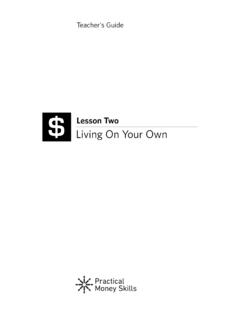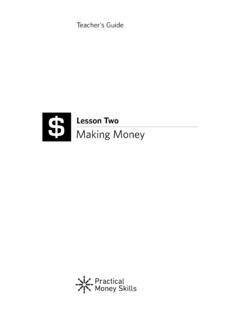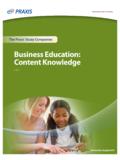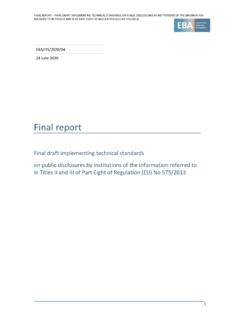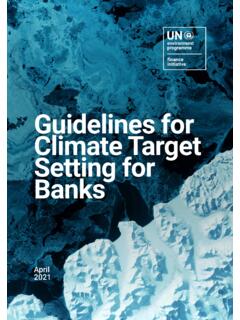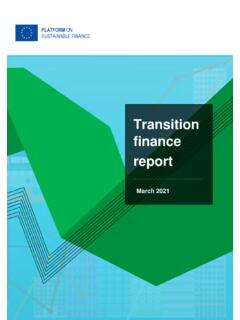Transcription of Lesson Six Banking Services - Practical Money Skills
1 Banking ServicesLesson Six$Teacher's GuideoverviewIf the fee for an ATM transaction to withdraw Money is $2 and a person withdraws Money twice a week, the Banking fees for that person will be $208 a year. Over a five-year period, those fees invested at five percent would grow to more than $1, students know that banks and other financial institutions (credit unions, savings and loan associations) offer a variety of Services . However, few people know how to make wise choices when using financial Services . In this Lesson , students will learn about the different types of financial service products available and the features of selecting a checking account, remind students to consider the required balance, monthly fees, interest earned, and charges for other fees and Services . goals Provide practice in comparing and evaluating various Banking Services , including checking and savings accounts, debit cards, and online Banking .
2 Perform the tasks associated with maintaining checking and savings objectives Understand the Services offered by banks, savings and loans, and credit unions List some of the factors to consider when shopping for bank Services Understand the responsibilities of having a checking account Write checks and keep a running balance in a checkbook Describe how to deposit a check Read and interpret a checking account statement Reconcile a checking account using a checking account statement and a check register Describe what a debit card is and explain how it is used presentation slides 6-A beware of these high-cost financial Services 6-B comparing checking accounts 6-C opening a checking account 6-D making a deposit 6-E endorsing a check 6-F writing a checkbanking Services Lesson Banking Services teacher s guide 6-ibanking Services Lesson Banking Services teacher s guide 6-ii 6-G
3 Keeping a running balance: check transaction, debit card transaction 6-H reading a bank statement 6-I reconciling a checking account 6-J electronic Banking Services 6-K cashless transactionsstudent activities 6-1 Choosing a Checking Account Using the guidelines provided in class, have students shop for a checking account Discuss what they found. Which bank or credit union would they choose? Why? 6-2 Keeping a Running Balance Using the examples provided, have students keep a running balance by reviewing account statements online and using a check register spreadsheet 6-3 Reading and Interpreting a Bank Statement Have students answer the questions regarding the sample bank statement 6-4 Reconciling an Account Using the examples provided, have students reconcile the example account 6-5 Lesson Six Quizsupplemental materials Banking Terms A Primer on Debit CardsFor more information, please refer to the activities appropriate to varied target audiences for Lesson Six activity teenagers young adults adults (14-18) (19-25)
4 (26+) Survey/Interview Student Activity 6-1 Student Activity 6-2 Student Activity 6-3 Student Activity 6-4 Web Activity Lesson Six Quiz 6-5 Banking Services target Banking Services teacher s guide 6-iiifinancial institutions and services1. Bank Services Checking and savings accounts Earning interest Direct deposit Transfer of Money Mobile Banking overdraft protection Traveler s checks FDIC (Federal Deposit Insurance Corporation) coverage Credit and debit cards Certificates of Deposit (CDs) ATMs Automatic payments2. Savings & loans (S&Ls) 3. Credit unions 4. How banks differ from savings & loans and credit unions advantages/disadvantages of having a checking account choosing a checking account 1.
5 Monthly fees 2. Per-check charges 3. Balance requirements 4. Interest rate 5. How rates are calculated 6. How soon you can draw against a deposit 7. Bounced check charges On your check On a check you deposited 8. ATM charges 9. Debit card charge 10. Stop payment fees 11. Security features 12. Charges for printed checks 13. Locations/number of branches 14. Bank hours 15. Online Banking Services 16. Automatic bill paybanking Services teaching Banking Services teacher s guide 6-ivdiscussionsurvey/interview:supplemen tal materialsHave students talk to others to obtain information about financial Services they use. discussiondiscussionstudent activity 6-1shopping for a checking account opening a checking account1. Signature authorization card2.
6 The contract and what it means3. Initial deposit making a deposit1. Writing a deposit slip for an ATM or branch deposit2. Endorsing a check Blank endorsement Restrictive endorsement Special (or full) endorsement3. Depositing a check Direct deposit Manual deposit Mobile deposit writing a check and keeping a running balance1. Writing a check2. Keeping a running balance by reviewing account statements online and using a check register or spreadsheet Banking Services teaching Banking Services teacher s guide 6-vstudent activity 6-1discussionslide 6-Cdiscussionstudent activity 6-2slides 6-F & 6-Gslides 6-D & 6-Eusing a debit card and keeping a running balanceBecause debit cards are widely used, a local bank employee would be a good guest speaker for this What a debit card is 2.
7 What it looks like3. Advantages of using it4. Disadvantages of using it5. Difference from a credit card6. How to use it7. What it costs8. Where it is accepted9. What it replaces10. Keeping a running balance by reviewing account statements online and using a budgeting app or a spreadsheetinterpreting a bank statement and reconciling an account1. Reading a bank statement2. Reconciling an account Checking the bank statement Verifying check transactions on your online statement Verifying deposits and ATM transactions Verifying debit card transactions Correcting entry errors in a check register or spreadsheet Correcting deposit or ATM transaction amounts in the spreadsheet Correcting errors of omission Finding outstanding transactions3. Practice reading a bank statement4.
8 Practice reconciling an account Have students supplement this activity by balancing their parents accountsbanking Services teaching Banking Services teacher s guide 6-vidiscussionsupplemental materialdiscussionstudent activity 6-3student activity 6-4slide 6-Honline and electronic Banking 24/7 account access Direct deposit Automated bill payments Money transfers Mobile check deposit Mobile account alertslesson six quiz Banking Services teaching Banking Services teacher s guide 6-viiquiz 6-5 keeping a running balance answer keyrecord deposits and keep a running balance using the spreadsheet On June 1, your balance is $ On June 4, you write check #160 to SoundOut, for $ to buy some new Then you realize the check to SoundOut should have been for $ , so you void the first check and write a new check (#161) for $ 4.
9 On June 7, you write check #162 to CellUSA for $ to pay for mobile Services on acct # On June 9, you make an ATM withdrawal of $ , so you ll have some spending On June 14, you make a mobile deposit of your paycheck, which is for $1, On June 15, you write check #163 for $1, to Woodland Apartments for rent. 8. On June 18, you use your debit card at Foodland Groceries for a $ On June 18, you make an ATM withdrawal for $ to pay for a movie and pizza. 10. On June 19, you used an ATM to transfer $1, from your savings account to checking. 11. On June 25, you write check #164 for $ to buy some new clothes at Tracy s. 12. On June 26, you write check #165 for $ to get some snacks at E-Z Mart. 13. On June 26, you use your debit card to pay City Transport $ for transportation On June 27, you take $ out of the ATM for spending On June 27, you write check #166 for $ to the Lawn On June 30, you get an ACH deposit for $ for your IRS tax Banking Services student activity key 6-2keeping a running balance answer Banking Services student activity key 6-2use the spreadsheet you just completed to answer the following questions:1.
10 What was your account balance on June 8? $ 2. Could you have written check #163 on June 6 instead of June 26? If not, why? No the payment was $ , but the account balance on June 6 was only $ 3. The love of your life has been in a bad mood lately, and you think an expensive present might help. You ve found a leather jacket on sale for $ Can you afford to buy the jacket on June 10? What will your account balance be if you do? No the account will be overdrawn by $ 4. The hottest new band in town has just released a CD. It costs $ Can you afford to buy the CD on June 5? What will your account balance be if you do? Yes $ 5. What was your account balance after you withdrew $ on June 27? $1, 6. What was the amount of check #161, to whom did you write it, and for what? $ , to SoundOut for new electronics.
